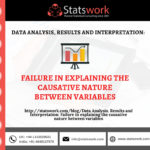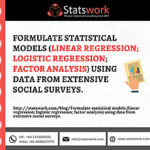Forecasting In Business Organizations, Issues Concerned With Forecasting Model Building In Regression
Predictive model or forecasting model plays a major role in many business organisations. It is a technique of anticipation and results in valid information related to the future. Forecasting models are the major part of planning activities in any business managements. Especially, in the field of marketing, forecasting model is atmost important to develop the production and increase the revenue. Thus, the forecasting model is widely used in recent years as the economic environment changes over the years. In other words, forecasting involves the collection of data about past and present and estimate the future. However, there exists a considerable gap between what is desirable and what can be attainable. In addition, the application of forecasting model using regression approach faces serious issues to deliver valid inference. In this blog, I will describe some of the issues or challenges in forecasting model using a regression approach (Makridakis & Wheelwright, 1977).
In practice, the application of forecasting can be made with proper selection of the method to be used, and the issues caused by selecting proper decision cannot be handled when we use the regression analysis. In that sense, there are three major issues in every forecasting model. They are (1) causal methods against the time series, (2) continuity of past data patterns and inadequacy of the available methods in data patterns (3) the accuracy of the model in the empirical approach and (4) qualitative data cannot be easily used for forecasting model using regression analysis.
Regression analysis is actually used to estimate the effect of the dependent variable over the independent variable. For instance, the impact or effect of sales on advertisement can be analysed through a simple regression by considering the effect of advertisement as the independent variable and the profit as the dependent variable. Regression analysis in forecasting studies the relationship between the dependent and independent variable and estimate the future. For example, it is used to predict the sales for the long term, to understand the inventory, to understand the demand and supply, to understand the impact of variables. The most business organisation uses simple regression analysis to predict the sales in upcoming years, say, may be for the next six months, to improve marketing promotions, to expand the business. However, there are certain assumptions to be made for conducting regression analysis, and this cannot be fully achieved in many real time situations.
Although there are situations where regression analysis is used to forecast the model, the following are the few limitations of regression analysis in forecasting the business data (Taylor & Letham, 2018).
- The relationship between the effect and cause may not be stable in a certain situation and hence the estimation of variable gives misleading conclusions.
- The relationship between the variables cannot be fully understandable if there are a large number of variables in the data.
- The main drawback is that it cannot be applied for the qualitative nature of data.
- In order to get a proper forecast, accurate data should be collected and often it is difficult to achieve in practice.
- The efficiency of the model requires a large amount of data, however, the regression assumptions will fail to satisfy if there are a huge amount of data.
Every business organisations either it is small or big, have to understand the trend or pattern in the performance and efficiency of the management and thus are advised to develop a forecasting plan to estimate the future needs. Forecasting the business problem helps in setting the business targets, develop proper decisions, understand the pattern of investors, satisfies the customer’s needs, etc. The business forecast can be done at various intervals (quarterly, half-yearly, annually) depending on the type of business organisations. Apart from the above said limitations, there are few challenges in this forecasting process (Hyndman & Athanasopoulos, 2018).
They are,
- The methods developed for forecasting cannot be repeated and compared with other because every year the requirement in the business will change and therefore there is no way to develop a common forecasting model.
- With the advent of many statistical tools in today’s world, most organisation do not utilize any quantitative analysis for forecasting purpose. Often they use only simpler techniques to predict the outcome. Thus lack of quantitative analysis in forecasting is the major reason for many misleading forecasting inferences.
- There is no proper maintenance of previous records about the trend in the business. Thus, the forecasting model will yield poorer results. If the data is stored in a proper way, then we may get an accurate prediction.
- Lack of business goals and no proper financial team to work for the development of business may also result in a poor forecast.
- Inadequate data at hand will result in poor efficiency.
- The proper methodology should be adopted for complex problems.
In summary, forecasting a business problem is a difficult task as it involves several challenges in predicting the future outcome in a stipulated time. It is even more difficult if there are no proper tools, if the assumptions are not met, and inconsistent data. Regression approach of forecasting is the most versatile method in many business organisations; however, it also faces some series drawbacks such as qualitative nature of data, complexity of the problem, time complexity and lack of adequate data. The accuracy of the forecasting is also a major task in any business forecasting. Thus, accomplishing a good forecasting model is a major issue in using the usual regression technique as it undergoes several pitfalls as I mentioned above.
Above blog referred here
- Hyndman, R.J. & Athanasopoulos, G. (2018). Forecasting: principles and practice. [Online]. OTexts. Available from: https://books.google.com/books?hl=en&lr=&id=_bBhDwAAQBAJ&oi=fnd&pg=PA7&dq=2.%09RJ+Hyndman,+G+Athanasopoulos+–+2018.+Forecasting:+principles+and+practice&ots=ThmYvnTRKO&sig=-r8MfJkFJ-9lJxC03XiQigrCVAk.
- Makridakis, S. & Wheelwright, S.C. (1977). Forecasting: issues & challenges for marketing management. Journal of Marketing. [Online]. 41 (4). pp. 24–38. Available from: https://journals.sagepub.com/doi/abs/10.1177/002224297704100403.
- Taylor, S.J. & Letham, B. (2018). Forecasting at scale. The American Statistician. [Online]. 72 (1). pp. 37–45. Available from: https://www.tandfonline.com/doi/abs/10.1080/00031305.2017.1380080.




 Previous Post
Previous Post Next Post
Next Post